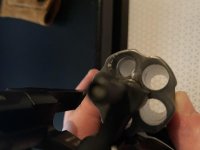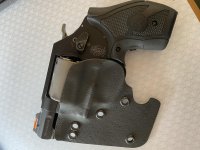krutsch
Member
Hi All,
I am pretty new to revolvers. I fell in love with the Model 360PD when I first held one (and fired one), so I bought a new one from my LGS.
I've decided to make this my summer EDC, so I want to practice with this gun as much as I am able.
.357 Magnum and .38 Special ammo was scarce, so I bought what I could find: Federal American Eagle 158 gr JSP, as well as some Buffalo Bore (125 gr JHP and 125 gr lead-free).
Well, I went to the range, fired a bunch of the Federal and the BB JHP. On my second range visit, I brought a glove, as my trigger finger was getting cut by the trigger guard - the recoil on this thing is real. I also added CT LG-405 grips, which has a stiff rubber back strap which helps a lot with the recoil.
On my second range trip, and after firing 10 rounds of the BB 125 gr lead free, I noticed this on the front of the cylinder (see attached image).
I contacted S&W and they promptly sent me an RMA number. Six weeks later, I have a new titanium cylinder installed and no questions asked - nice customer service from S&W.
Yesterday, I returned to the range with some .38 Special (Federal Punch +P, Buffalo Bore +P 'heavy', Fiocci wad-cutters), as well as Hornady .357 Magnum Critical Defense. By the way, the Buffalo Bore .38 Special +P 'heavy' felt like a .357 round, recoil and muzzle blast-wise.
The Hornady .357 was 'relatively' low recoil, compared with the other .357 rounds, but one round threw out some debris from the cylinder gap and left a small cut on my forehead. A gentle reminder of why we wear eye pro.
After the range visit, I examined my cylinder face and found a single, very small 'nick'. Similar to what's in the attached photo, but much smaller in comparison. Maybe from that Hornady round? Who knows...?
I have cleaned this gun with kid gloves - Hoppe's #9 solvent (only for the bore) and #9 oil with cotton swabs and patches - no brushes on the cylinder.
Now, I am wondering if I should even be firing this on the range and keep it only for carry. I noticed at my LGS that the new M&P 340 has a stainless steel cylinder; I am guessing that S&W has had to replace a lot of damaged titanium cylinders and they've had enough of that.
So, it seems like my choices are:
1) get a M&P 340 and practice without fear of damaging the gun, then carry the 360PD (another $800?),
2) practice and carry the 360PD with .38 Special +P (which I am guessing is easier on the cylinder,
3) go back to .40 or 9mm semi-autos.
EDIT:
4) Stick with heavier ammo, like the Federal 158 gr JSP, which might be better for the cylinder flame cutting problem?
I am pretty new to revolvers. I fell in love with the Model 360PD when I first held one (and fired one), so I bought a new one from my LGS.
I've decided to make this my summer EDC, so I want to practice with this gun as much as I am able.
.357 Magnum and .38 Special ammo was scarce, so I bought what I could find: Federal American Eagle 158 gr JSP, as well as some Buffalo Bore (125 gr JHP and 125 gr lead-free).
Well, I went to the range, fired a bunch of the Federal and the BB JHP. On my second range visit, I brought a glove, as my trigger finger was getting cut by the trigger guard - the recoil on this thing is real. I also added CT LG-405 grips, which has a stiff rubber back strap which helps a lot with the recoil.
On my second range trip, and after firing 10 rounds of the BB 125 gr lead free, I noticed this on the front of the cylinder (see attached image).
I contacted S&W and they promptly sent me an RMA number. Six weeks later, I have a new titanium cylinder installed and no questions asked - nice customer service from S&W.
Yesterday, I returned to the range with some .38 Special (Federal Punch +P, Buffalo Bore +P 'heavy', Fiocci wad-cutters), as well as Hornady .357 Magnum Critical Defense. By the way, the Buffalo Bore .38 Special +P 'heavy' felt like a .357 round, recoil and muzzle blast-wise.
The Hornady .357 was 'relatively' low recoil, compared with the other .357 rounds, but one round threw out some debris from the cylinder gap and left a small cut on my forehead. A gentle reminder of why we wear eye pro.
After the range visit, I examined my cylinder face and found a single, very small 'nick'. Similar to what's in the attached photo, but much smaller in comparison. Maybe from that Hornady round? Who knows...?
I have cleaned this gun with kid gloves - Hoppe's #9 solvent (only for the bore) and #9 oil with cotton swabs and patches - no brushes on the cylinder.
Now, I am wondering if I should even be firing this on the range and keep it only for carry. I noticed at my LGS that the new M&P 340 has a stainless steel cylinder; I am guessing that S&W has had to replace a lot of damaged titanium cylinders and they've had enough of that.
So, it seems like my choices are:
1) get a M&P 340 and practice without fear of damaging the gun, then carry the 360PD (another $800?),
2) practice and carry the 360PD with .38 Special +P (which I am guessing is easier on the cylinder,
3) go back to .40 or 9mm semi-autos.
EDIT:
4) Stick with heavier ammo, like the Federal 158 gr JSP, which might be better for the cylinder flame cutting problem?
Attachments
Last edited:


